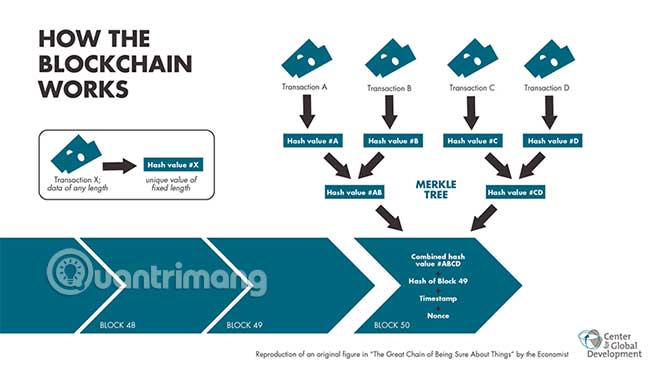Difference between Permissioned and Permissionless Blockchain
One of the biggest parts of blockchain technology is permissioned blockchain (licensed or closed blockchain) and permissionless blockchain (blockchain without permission or open blockchain). The basic difference is quite clear: You need approval to use a permissioned blockchain, while anyone can participate in permissionless systems. For example, the original Bitcoin blockchain was still completely open, but when companies and organizations started adopting this technology, they were ready to sacrifice trust and transparency to gain access control as well as Customize more easily.
Permissioned and Permissionless Blockchain really shouldn't be used for the same thing. For example, people may not be interested in using a permissioned cryptocurrency, because one of the biggest selling points of cryptocurrencies is that no one can control how it works. its or where it comes from. In contrast, a company like Maersk, which uses blockchain to track its shipping logistics, doesn't want to put all its confidential data on a permissionless blockchain.
Compare Permissioned and Permissionless Blockchain
- What are the similarities of Permissioned and Permissionless Blockchain?
- What is the difference between permission and permission?
- Permissionless Blockchain
- Permissioned blockchain
- Is permissioned or permissionless blockchain better?
What are the similarities of Permissioned and Permissionless Blockchain?
Both permissioned and permissionless blockchain have some important characteristics:

- They are two distributed ledgers, meaning there are multiple versions of the same data stored in different places and connected via several types of networks.
- Both use some form of consensus mechanism, meaning they have a way for multiple ledger versions to reach consensus on what they actually look like.
- Both are theoretically immutable in the sense that the data they store cannot be altered without sufficient network control. Even then, the blocks (blocks) linked by the cryptographic hash function will change if any data is changed.
Put simply, both permissioned and permissionless blockchains use encryption and decentralization to varying degrees, to accurately store data in formats that are difficult to hack or change.
What is the difference between permission and permission?
Permissionless Blockchain
Most blockchains you've heard of fall into this category: Bitcoin, Ethereum, Litecoin, Dash and Monero. All else is a public blockchain that anyone can transact or even participate in as validators.

All data stored on these chains is publicly available and full copies of the ledger are stored worldwide. That's what makes these systems so difficult to hack or censor. Nobody runs the blockchain, nobody can restrict access to it, and you remain relatively anonymous because you don't need to verify yourself to get an address and make transactions.
This type of blockchain tends to resonate because it has what underlies most of the most interesting cryptocurrencies and decentralized solutions. This hype is worth it, because public permissionless blockchains are able to revolutionize services that previously required trusted middlemen - not just money. For example, a car's immutable blockchain can give you the ability to look up reliable data on every part, service record, and transaction related to a used car, instead of trust a middleman.
Of course, this system is not perfect. It can be slow, difficult to build and scale, too transparent to store sensitive data, difficult to control access, and power-consuming and complex. That's why permissioned blockchains are becoming a more popular solution for companies and organizations that want to use blockchain to replace traditional systems.
Permissioned blockchain
In summary, permissioned blockchain is only for those who are allowed to access. Anyone who wants to authenticate transactions and / or view data on the network, must first be approved by the central authority.

This is especially useful for banks, companies and other organizations that have to comply with the rules and don't want to lose complete control of the data. Instead of building on a large, decentralized blockchain like Ethereum, these units can create a custom solution, run only by the organizations they approve.
Imagine a watermelon company that takes their supply chain to the next level:
1. The company decided to build a blockchain system to track its fruits from the farm to the store. They want to know exactly who is involved in each step, so the company decided to use a permissioned blockchain that can only be accessed by authorized users.
2. They build Melonchain and give each point in the supply chain a way to access and add data, authenticated by a network of servers run by the company. This way, whenever the data for a melon is recorded, it can be looked up in the ledger and verified by the code afterwards.
3. Certain data on each watermelon, such as the date and place of harvest, is made available to the consumer, while other data, such as precise movement in the supply chain, are kept secret. security to help the company maintain a competitive advantage.
Facebook's Libra cryptocurrency is another good example. It may be available to the public in the future, but at the time of launch, only a select number of companies, invested and approved, have the right to operate it and users may have to register by name authenticity.
The big advantages of permissioned blockchain are that they have:
- Access control rights
- Highly customizable
- Easier time changes to comply with the regulations
- Better energy efficiency
- Better scalability
However, they also have drawbacks. That is:
- Focus more
- Less transparent
- More vulnerable to attack and manipulation
- Easier to censor
- Less anonymous
Is permissioned or permissionless blockchain better?
The permissioned and permissionless blockchains are just branches of the same technology, developed to meet many different needs. Both are useful in their own way, for almost every purpose and technology different in practice.
This means that the benefits of permissionless blockchain do not directly affect licensed systems, so just because a company says it uses blockchain technology doesn't necessarily mean it's private or decentralized. much more central than the traditional database. Knowing the difference between permissioned and permissionless blockchain is a very important part.
You should read it
- Blockchain programming part 4: Java programming language
- [Infographic] The effects of Blockchain on E-commerce and Security
- Programming blockchain part 5: Solidity programming language
- Programming blockchain part 1: C ++ programming language
- Here are the 3 most readable blockchain books
- Programming blockchain part 3: Python programming language
 The function frozenset () in Python
The function frozenset () in Python Save your database with Recovery Toolbox for MySQL
Save your database with Recovery Toolbox for MySQL Do you know what programming language is?
Do you know what programming language is? Overview of R language, install R on Windows and Linux
Overview of R language, install R on Windows and Linux Formula to calculate trapezoidal area: normal, square, weight
Formula to calculate trapezoidal area: normal, square, weight 9 extension Visual Studio Code for easier programming
9 extension Visual Studio Code for easier programming